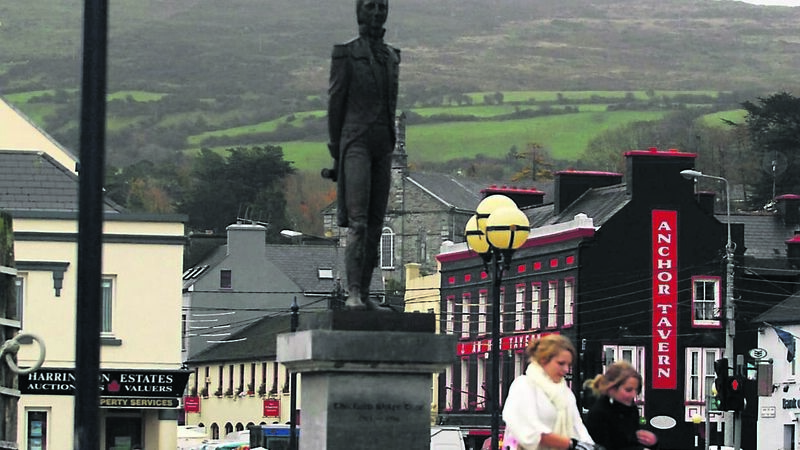‘Hanging Trees’ of Rathcormac that still recall horrors of 1798

That year was the centenary of the United Irishmen’s Rising of 1798 and all over the country commemorative events were held.
Growing up, Jerry would have heard tell of the Dahill family, who had a forge not far away from the Roche homestead in Ballyda. Though the forge was long gone, the actual site where it once stood is still pointed out and Jerry knew people in his youth in the 1890s who remembered seeing the ruins of the building.
In the 1930s and for years afterwards, the Roches had a small grocery shop at the crossroads - to this day we call it ‘Johnny’s and Jerry’s’. The shop was long gone by the time I got to know Johnny and Jerry in the 1970s.
I visited their home in January, 1975, with a tape recorder to tape ‘talk and tunes’ from the brothers. We were doing a local history project for our Macra na Feirme branch and the Roche brothers were great to talk.
Jerry was 89 then and Johnny 78 - he died just a few months later. They spoke reverentially about the Dahill family and knew of their involvement in 1798. It was always said in the locality that pikes were made at the Dahill forge, in readiness to fight the Redcoats in ’98.
We went to Bantry on Friday evening to attend a ‘Joe Dolan Tribute Show’. Joe died in 2007 but, nearly 15 years later, his brother Ben and nephews Adrian and Raymond and niece Sandra keep his memory and his music very much alive.
Oh Lord, but we travelled near and far to see Joe - God knows we still miss him ‘in our own peculiar way’.
It was a brilliant show on Friday night. Saturday morning saw us in the historic Square in Bantry. It might be still April but the jewel of West Cork was bathed in glorious sunshine under a clear blue sky.
Bantry is a special place for us -Mary’s mother was born there in September, 1922. We walked up the rising road by the Boston Bar, across the road was the site of Tommy Harrington’s forge -it’s a beer garden now! Tommy was married to Anne O’Connor.
Around the corner then onto Blackrock Road where we stood outside No 1. This was once the home of the O Connor family and the house where Kitty O Connor was born.
Her mother was Mary O Connor, nee Daly. I met her just once. I called to her home and she must have been a bit surprised to see a young fella with a head of foxy curls and a freckly face ‘doing a line’ with her granddaughter!
Theobald Wolfe Tone’s family had originated in France but came to England because of religious persecution. His ideal was for a free Ireland with Catholic, Protestant and Dissenter all united in a common cause.
The United Irishmen were a secret Society where members swore oaths to free Ireland and rid the land of all oppressors.
In October, 1798, in a public house at Curraglass - between Conna and Tallow - John Dahill got Thomas Magrath to swear an oath of allegiance to the United Irishmen “to be true to the French convention and to assist in planting the tree of liberty in Ireland”.
The Rising of the United Irishmen was savagely defeated by Crown forces. They showed no mercy and the awful carnage, especially in County Wexford, is still recalled today:
(There was no one could sing that song like Brendan Bowyer).
All over the country, members of the United Irishmen Society were arrested after the Rising was suppressed. In Cork, Magrath ‘took the King’s shilling’ and gave damming evidence against Dahill and others.
On Saturday, June 16, John Dahill and Nicholas Burke were court-martialled for the administration of illegal oaths. Both were found guilty, sentenced to death, and executed by hanging.
On the outskirts of Rathcormac village, the ‘Hanging Trees’ can still be viewed. Originally there were four, three remain to this day.
The late Tom Barry BE of Rathcormac, a noted local historian, did extensive research into the events of 1798 in the Cork area. He determined that Dahill’s execution took place in Curraglass. His body was then brought back to Rathcormac for burial - because his family were from here.
It is possible that Dahill’s body was left ‘hanging’ from one of the trees in Rathcormac - to ‘make an example’ of him to locals yearning for freedom.
Dahill was just 38 when executed. A fine headstone stands over his grave. On it was inscribed his name and the fact that he ‘died a martyr’. No truer words were ever chiselled on stone, but in the late 1700s Rathcormac was an Ascendency town, returning two MPs to the Irish parliament.
The local gentry took offence at the veracity of what was on Dahill’s headstone and had the words ‘a martyr’ chiselled out. Their action had the opposite effect from what they planned. Instead of fading away into oblivion, the memory of Dahill lives on.
In 1998, to mark the bicentenary of the ’98 Rising, Cork sculptor Ken Thompson restored the Dahill headstone to it’s original condition. At a moving ceremony, a relative of the 1798 martyr, Edward Dahill, from California, laid a wreath on the grave of his ancestor. This same Edward Dahill has passed away since and his ashes were brought across all the miles from the USA to mingle with the bones of his relations in the cemetery in Rathcormac.
Long after the trees are gone, they will be spoken of, and their vital role in our local history will live on into the future.
A month after John Dahill was hanged, his 73-year-old father Garrett died - perhaps of a broken heart, and in November of that same year a broken and disillusioned Wolfe Tone breathed his last in Dublin. He was only 35.
Last Saturday in Bantry, I remembered Johnny and Jerry talking of Dahill’s forge and of Tone and John Dahill too, and the O’Connor family of Blackrock Road and of Tommy Harrington’s forge. What history we have all around us - if only the French had come in ’98, but sure that’s the way things happened.
Great happenings in great places and little things in small places, that’s the jigsaw that makes us and our country so special.







 App?
App?




